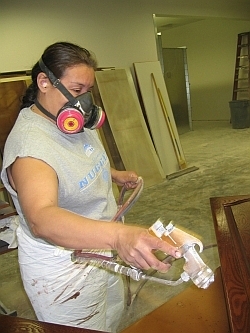million dollar man, 500+ custom cabinet drawings per year
build to suit restaurants, up to 10,000 square feet, 3 kitchens, and an elevator
TurboCAD, MegaCAD, SilverScreen Solid Modeler, CabinetVision Solid
Excel, Word, PowerPoint, Outlook, Access, FrontPage, Custom Style Sheets (css)
Into the frying pan...
Besides the challenge of getting use to sitting in an office, the most daunting task I have
in manufacturing is deciding what information is important, pulling it from the chaff, and
then putting it in a form that people can digest so they can make the best decision.
Whether it is production data, a spreadsheet, or the pros & cons of cheery vs alder kitchen, to make
a good decision there has to be a balance between too much or too little information, or the consequence is
being caught in indecision or making the wrong choice.
Selling the idea!
I never found it persuasive convincing someone to follow my lead by being the "decider." What I found works,
is respecting people and making them part of the process. In our wood production we sold door elements: styles,
rails and panels, the parts of interior-exterior and cabinet doors. Each type element had a specific selling value
with the exterior-interior door style selling at the highest price. The problem was that we sacrificed profit
of the whole program trying to keep a high output of long styles that produced terrible waste. To demonstrate
this I used Excel Solver and a simple measuring board set on the re-cutting stations that calculated the best
cuts based on the length and cost of the board and the size and type of elements we could remove from it. What I
was able to demostrate by tracking the difference between cutting as we had been doing it and using a measuring device
were profits. With a qualitative difference between the two it didn't take me telling anyone what was right.
Finding a better way!
I worked as a designer for Tharp Cabinets but it didn't mean I couldn't offer a new approach to helping production.
The company's sales had nearly doubled and they had already outsourced door production but were running out of space.
They still made the parts for the face-frames in-house. This took a lot of manpower and storage. I proposed making
this off-site. A molding company could hold higher tolerances, free-up space and manpower. After weighing the costs,
the switch was made. No matter where I am or my position, it's about finding solutions.
Who's the "Boss"?
Not having been with a fortune 500 but coming from 1 of 9 children, I know how important it is to establish boundaries
and work within them. I've worked for bad bosses, those that thought keeping every one on edge brought out the best
and others that created a dysfunctional environment by pushing for harmony at all costs. But the worst, and most
disruptive to a company are those who constantly change rules. You can have the best business in the world but if
employees don't know where they stand the first to go are the most talented. I've worked for great people too, and
the easiest way to judge a quality company is the rate of employee turnover. That's hard in manufacturing when the
division of labor is based on repetitive piecework. Not only are these managers able to set boundaries and expectation,
they leave their employees with a feeling of pride, high morale and identifying with their product. That's who I want to be.





